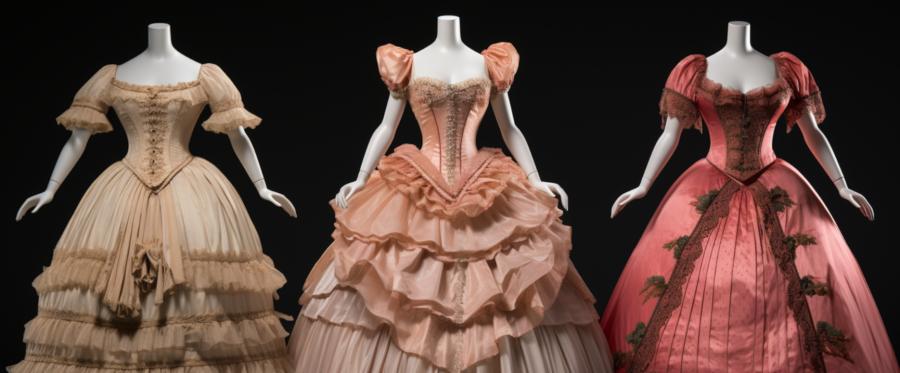Crinoline Craze: Mid-Victorian Fashion Fervor

Introduction to Crinoline Mania
Picture it, if you will: a bustling mid-Victorian street, teeming with pedestrians and carriages, the air thick with the scent of soot and the chatter of commerce. Suddenly, an apparition emerges from the crowd, a woman clad in a dress that seems to have swallowed a small planet, her waist cinched to a circumference that rivals a maypole, and the fabric of her dress billowing out like the sails of a ship bound for the shores of fashion excess. This, dear friends, is the crinoline craze, a bizarre chapter in the annals of sartorial history that captivated the public and raised more than a few eyebrows.Unraveling the Crinoline Conundrum
Crinoline, for those uninitiated in the lexicon of Victorian fashion, can refer to two things: a stiff petticoat made from horsehair and cotton or linen, or the steel-cage contraption that replaced said petticoat and created an architectural foundation for the gravity-defying hoop skirts that were all the rage in the 1850s and 1860s. The word 'crinoline" itself is a portmanteau of the French 'crin" (meaning horsehair) and 'lin" (meaning linen), which is undoubtedly more appealing than the alternative moniker, 'horsehair underpants.'So, how did such a seemingly cumbersome garment become a must-have accessory for the fashionable mid-Victorian woman? The answer lies in a potent concoction of social mores, technological innovation, and good old-fashioned consumerism.
Social Mores: Size Matters
It's no secret that throughout history, the size of a woman's waist has been a hotly debated topic. In the mid-Victorian era, a wasp waist was the epitome of feminine beauty, but achieving this coveted silhouette was no easy feat. Enter the crinoline, a godsend for women who found themselves unable to cinch their waistlines to the desired 16 inches.With the crinoline's ability to create a dramatic contrast between the waist and the hips, suddenly, even the most robust woman could achieve the illusion of an impossibly tiny waist. Of course, this newfound svelte figure came at a price: maneuverability. But who needs to be able to sit down or walk through a doorway when you look like a fashionable bell?
Technological Innovation: Steeling the Show
While crinoline petticoats had been around since the 1820s, it wasn't until the advent of steel cage crinolines in the 1850s that the craze truly took off. Thanks to the miracles of modern manufacturing, these lightweight and collapsible contraptions could be mass-produced and sold at a price that was affordable for the average woman. It was a classic tale of supply and demand: the public clamored for crinolines, and the textile industry was more than happy to oblige.Of course, the march of progress did not stop there. By the 1860s, crinolines had evolved into the crinolette, a half-cage concoction that focused on the posterior, giving rise to the bustle and a whole new set of fashion challenges. But that, as they say, is a tale for another day.
Consumerism: The Business of Fashion
As with any fashion trend, the crinoline craze was fueled by a desire to keep up with the Joneses, or in this case, the Queen. With Queen Victoria herself sporting the latest in crinoline couture, it was only natural for the rest of society to follow suit. And follow, they did. It is estimated that by the height of the crinoline craze, over a million of these peculiar undergarments were sold in Britain alone.It wasn't just the ladies who benefited from the crinoline boom. The textile industry saw a massive uptick in profits, as the demand for ever-larger skirts meant more fabric, and more fabric meant more money. It was, in a very literal sense, a fashion feeding frenzy.
Crinoline Calamities and the Decline of the Hoop Skirt
As with any great upheaval in the world of fashion, the crinoline craze was not without its casualties. There were reports of women being swept off of cliffs by gusts of wind, trapped in machinery, and even set ablaze due to the highly flammable nature of their voluminous skirts. It seemed that for every woman who was enchanted by the allure of the crinoline, there was another who was quite literally consumed by it.By the late 1860s, the writing was on the wall for the crinoline. The rise of the bustle signaled a new era in women's fashion, one that, while still far from practical, at least allowed for a greater degree of mobility. And so, the crinoline craze faded into the annals of history, a testament to the capricious nature of fashion and a reminder that sometimes, bigger is not always better.
Article kindly provided by foreverinfashion.org
Latest Articles
- The Psychology of Tattoo Aesthetics: Why Certain Imagery Resonates
- Style That Works With Your Body, Not Against It
- Fashion Tourism on Wheels: Curated Shopping Routes Led by Chauffeur Guides
- The Charm of Certainty in a World of Indecision
- Can an Everyday T-Shirt Be Turned into a Modern Heirloom?
- Color, Ceremony, and the Psychology of Celebration
- Styling Graphic T-Shirts for Different Body Types
- Getting Kids to Wear Their Hats Without a Bribe or a Meltdown
- Mastering the Art of Being the Unnoticed Photographer
- Quiet Sportswear Moves Loudly
- Fashion's Most Misunderstood Color Is Brown
- Weight Matters When Cotton Gets Real
- SKU's Out for Summer: Why Your Warehouse Is Melting Down
- Ink as Accessory - How Tattoos Are Replacing Jewelry in Modern Style
- Accessories
- Jewellery
- Footwear
- Skirts and Dresses
- Shirts and Blouses
- Beauty and Makeup
- Fashion Photography
- Sustainable Fashion
- Street Style
- Fashion History
- Fashion Business
- Fashion Styling
- Fashion Events
- Plus-Size Fashion
- Men's Fashion
- Women's Fashion
- Fashion Blogging
- Fashion Trends
- Fashion Retailers
- Fashion Tips and Advice
- Fashion Business Startups
- Fashion Around the World
- Lingerie
- Sportswear
- Weddings

